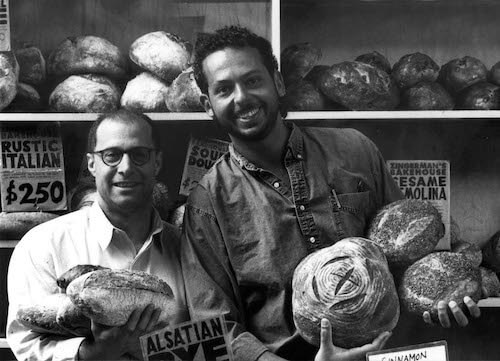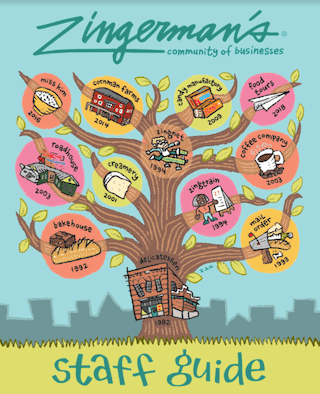Zingerman’s Deli might be known for its reuben, but its true legacy lies in its approach to employee experience. In fact, the Michigan-based food business group is so passionate about employee experience that it launched a spinoff. ZingTrain is a training consultancy that drives Zingerman’s employee training program while also sharing its expertise with other brands looking to optimize their EX.
So when we wanted to get a behind-the-scenes look at Zingerman’s legendary employee training and development programs, we knew exactly where to go.
“Training has always been important to Zingerman’s,” says Maggie Bayless, founding partner of ZingTrain. “We try to always think about what it takes to help people be successful.”
First: a bit of background on Zingerman’s and ZingTrain.
Zingerman’s and ZingTrain: the backstory
The OG Zingerman’s Deli was founded in 1982 by Paul Saginaw and Ari Weinzweig. Then, rather than take a franchise model to growth, Saginaw and Weinzweig opted to partner with passionate entrepreneurs to develop independent businesses in the Ann Arbor area: bakeries, a Korean restaurant, a cheese shop, a candy store…even an event venue and travel food tour service. Now, the “Zingerman’s Community of Businesses” includes 10 businesses in the Ann Arbor area. But one founding principle that’s been with the community since the very beginning is a commitment to stellar employee experience.
 “From the very beginning they wanted to create an organization where not only people wanted to come to shop, but people wanted to come to work,” says Bayless. “The employee experience has just always been a big piece of Ari and Paul’s vision.”
“From the very beginning they wanted to create an organization where not only people wanted to come to shop, but people wanted to come to work,” says Bayless. “The employee experience has just always been a big piece of Ari and Paul’s vision.”
So, naturally, a core component of Zingerman’s was employee training. “They wanted to help people be successful,” explains Bayless.
But, employee training needs structure. Especially as Zingerman’s started to open additional businesses, they knew they needed a way to standardize their process to ensure consistent baseline of execution and customer experience across current and future businesses. And that’s where ZingTrain came in. But ZingTrain couldn’t just be the employee training department. If it was going to be in Zingerman’s Community of Businesses, it needed to generate its own revenue. So, Bayless suggested that ZingTrain could show other brands how to elevate their CX.
“At that point, Ari and Paul were getting requests to teach Zingerman’s approach to customer service to other organizations, so it felt like there might be a business case there,” says Bayless.
Zingerman’s approach to customer service
When your businesses range from event spaces to candy shops, how do you create a baseline of CX? How can Zingerman’s approach to customer service apply to their whole community?
To start with, there’s a common denominator: people. “What we find, keeping it from a consistency standpoint, is that it’s all working with people,” explains ZingTrain managing partner Katie Frank. “Even IT service providers that are working with technology, there are still humans interfacing with that. So we find that keeping one approach is critical from a consistency standpoint.”
 As anyone who has read Zingerman’s employee handbook knows, they’re a fan of organizational “recipes”: simple, easy-to-follow guidelines for employee behavior or task execution (which is music to our ears – we love a bite-sized comm). And early on, co-founder Ari Weinzweig came up with the “3 Steps for Great Service”:
As anyone who has read Zingerman’s employee handbook knows, they’re a fan of organizational “recipes”: simple, easy-to-follow guidelines for employee behavior or task execution (which is music to our ears – we love a bite-sized comm). And early on, co-founder Ari Weinzweig came up with the “3 Steps for Great Service”:
- Figure out what the customer wants.
- Get it for them: accurately, politely and enthusiastically.
- Go the extra mile.
The three-step system is simple, and can be modified to different roles or businesses, but provides a baseline to unite all of Zingerman’s businesses under one approach to CX. Zingerman’s has similar “recipes” for handling complaints, order accuracy, employee conflict resolution – you name it.
“I know to follow these steps, and at the end I can know if I’m successful or not,” says Frank.
But there’s something else that aligns every Zingerman’s employee in their pursuit of next-level CX: their employee experience.
The role of employee engagement
Employee engagement is so at the core of Zingerman’s entire approach to employee experience, it’s hard to imagine the company without it. Case in point: when asked about the business case of employee engagement, Bayless didn’t even know how to answer the question.
“I don’t even understand the question. How can you have an organization without the employees? How could they not be important?” she said. “I just can’t see needing to make a business case for employee engagement.”
For Bayless, and the entire Zingerman’s leadership team, employee engagement isn’t a nice-to-have, it’s a must-have. It’s what gets the organization where it needs to go. “The more engaged employees are and the more they understand where you’re trying to go as an organization, and the more bought-in they are to where you’re going, the more they understand how they can have an impact,” she explains.
Tools for employee experience
So what does the Zingerman’s employee experience look like? What does employee engagement look like, for that matter? At Zingerman’s, it’s a complex ecosystem. “You can have a really great heirloom seed, but if the soil is poor, it’s not going to result in a great tomato,” says Frank. “When we talk about the tools that help with employee experience and culture, there’s a lot that goes into it. It’s hard to just isolate one part of the garden and say, that’s why it was successful last year.”
With that in mind, here are a few of the major components of Zingerman’s employee experience:
A written vision created by the organization – and shared with the organization
“This is about being transparent about where we’re going,” says Bayless. Zingerman’s co-founders have repeatedly developed and shared long-term visions for the organization. The first one, written in 1994, shared their vision for where they wanted to be by 2009. In 2007, they launched their 2020 vision, and last year they published their vision for 2032. These visions give staff a clear sense of where the company is headed, and what their role will be in moving the organization forward.
But it’s not just about sharing the vision – it’s about creating it together. “Only the 2009 vision was written by Paul and Ari alone,” explains Bayless. “Every subsequent vision has involved everyone in the organization who chose to get involved. The first drafts were developed by the partners group and then town hall-style meetings were held to share the drafts and solicit feedback. That feedback was then reviewed, and a small writing team of both partners and other staff developed the next draft. Each vision went through several drafts before being finalized and then adopted by consensus.”
Transparency in how decisions are made
Equally critical to Zingerman’s approach to employee experience is transparency around where decisions are made within the organization, and how they’re made. And part of that is having systems that allow staff to have input on those decisions.
“People need to know how to make suggestions,” says Bayless. “They need over time to feel that their ideas and input are valued. Because who wants to be somewhere long-term where you’re not heard?”
They call this system the “Bottom-Line Change” process, and it outlines exactly what a staff member needs to do if they want to suggest a change at the organization (again: clear, concise information for the win!). Staff can even attend classes on “Bottom Line Change” to learn how best to bring forward a change that they’d like to see made.
That doesn’t mean every single idea is implemented – but that’s not the point. Staff need to feel heard, no matter what the feedback they’re sharing.
“That’s actually one of the most interesting things we’ve seen working with other organizations through ZingTrain,” says Bayless. “That people say they want employee input, but then they’re disappointed with the input that they’re getting. But wait – just look at that. Is it because it’s not aligned with where the organization’s going? Do people need to have better information? Are they just not good enough because they’re not your ideas?”
A “training compact”
The very first page of the Zingerman’s staff guide is a Training Compact, which outlines what the trainer agrees to do, and what the trainee agrees to do. Essentially, the trainer agrees to document clear expectations, provide the training to meet those expectations, and recognize and reward performance. The trainee, meanwhile, agrees to take responsibility for the effectiveness of their training.
“We believe that the responsibility is 100% on both sides,” says Frank. “We hire great folks and then the compact says, we’re going to treat you like an adult. I don’t know how you learn, so if you need more training on something I expect you’re going to ask me. It takes people out of the passive.”
From there, staff have “training passports” that outline these expectations in detail, explains the training process, and generally gives new hires a sense of what to expect in seven days, 30 days, 60 days, and onward.
It seems simple: tell people what you want them to do, give them the tools and training to do it, and reward them when they do it. So why do so many frontline organizations still struggle with employee communication and supporting their staff?
“learn how best to bring forward a change that they’d like to see made,” says Bayless. “I just think they don’t realize that it’s not clear.” I think a lot of people in leadership got to where they are because they were pretty good at reading their bosses’ minds. And so then they think people should be able to read theirs. And I just think that’s such a waste of time.”
—
In fact, if you look beyond the lists and compacts and staff guides, Zingerman’s entire approach to employee experience is surprisingly simple: trust your employees to do the right thing – by giving them the right tools, training, and support.
“Most people want to do a good job. They want to make a contribution. Yes, there are people that just want to punch the clock and go home. But I don’t think that’s most people,” says Bayless.
“People spend a big chunk of their life at work. They want to be engaged and feel like they’re building something, and that their brain is being used. I think that for a long time people just didn’t think that was possible at work, so they didn’t ask for it. But I think people always would have liked it.”
And now, increasingly, frontline employees are asking for it. And while some organizations are scrambling to figure that out, Zingerman’s is keeping on course. Until 2032, at least.

